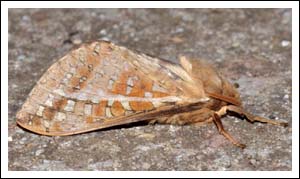Trictena atripalpis is commonly known as the Rain Moth, due to its habit of emerging from the ground with the autumn rains, and then often fluttering at lighted windows at night. It is variable in colour and pattern, and it is possible that more than one species may be lumped under the T. atripalpis name. (MOV 6) In the latter they have been separated into two groups, a larger plain form with less reticulate wing markings and brown antennae, and a smaller form with more defined reticulate markings and dark antennae. The first image is a female of the first group, then a male in the second group. The larvae of this moth live in tunnels underground, where they feed on the roots of trees such as the red and manna gums. When the adult moth emerges, the empty pupal case can be seen protruding from the tunnel.
The next moth, the Intricoid Corbie, Oncopera intricoides, is noted in MOV 6 as being rarely encountered and apparently restricted to forested areas. This individual, the only one I’ve recorded was photographed in Red Gum and Silver Wattle bush beside the Macalister River in Bellbird Corner reserve. The larvae live underground and emerge at night to feed. The main flight times are from October to January, this individual was recorded in November 2011.
Oxycanus dirempta, known as the Variable Oxycanus, is in fact just that, very variable, and again MOV 6 notes that more than one species may be involved. The larvae emerge from their vertical tunnels in the ground to feed on leaf litter at night. The first two images show some of the variability. Flight time is autumn to early winter.
Very similar, Oxycanus australis.
MOV 6 notes that Oxycanus janeus, the Mountain Oxycanus was first recognised as being present in Victoria in 2009, it inhabits dry sclerophyll forest, but this one was photographed at a lighted window in a native garden environment with many trees, just outside Maffra in May 2011. The flight time is as for O. dirempta.
The final post in this series will deal with local moths in the genus Abantiades.
Click images to enlarge.
References and further reading, Moths of Victoria Vol. 6.
Australian Moths.







